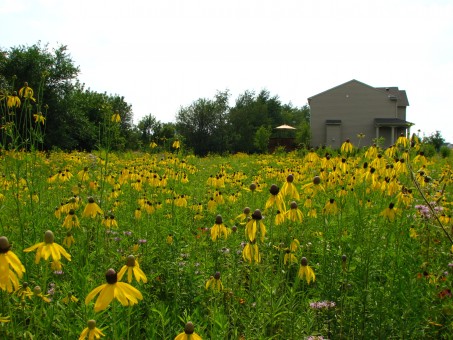
By Debra Sigel
Dan McCord of the Hamilton County Urban Conservation Alliance has assisted on several restoration projects such as the installation of a schoolyard’s native habitat at Shamrock Springs Elementary School in Westfield and the conversion of common area spaces into prairie ecosystems in various local neighborhoods.
And he said he has found that the conversion from turf grass to a prairie habitat can be a money-saver for homeowners’ associations that have to maintain large common areas.
How much?
Almost $8,000 in one neighborhood due to reduced maintenance needs.
McCord, who sits on the board of the Ridgefield Homeowners Association in Fishers, proposed turning that neighborhood’s common areas into land filled with native plants instead of the standard turf grass.
The project consisted of planting approximately 4.5 acres of native warm-season grasses and wildflowers in the neighborhood’s meadow and around its retention pond. In addition, over 300 native trees and shrubs were planted.
The native plants essentially take care of themselves because it is not necessary to mow, fertilize or water them as it is for turf grass.
The HOA no longer spends more than $8,000 a year to maintain the area. Instead, residents now spend under $1,000 per year, while creating an ecological benefit to the neighborhood and an opportunity for wildlife habitat.
“Converting the area to native plants improved the water quality in the neighborhood retention pond, as well as eliminating the goose nuisance issue,” McCord said. “Finally, the common area has become a wildlife haven.”
If caretakers provide food, shelter and cover, wildlife will have means to survive, he said. If you take those things out of the environment, then a prairie cannot survive.
“You will be surprised what will show up to live in the habitat,” McCord said. “Native flowers, butterflies, songbirds, beneficial insects and other interesting wildlife (will appear).”
His organization has extensive experience planting native trees, shrubs and grasses and can assist in planning, designing, preparing and implementing these projects.
“We need to get out of the mindset of mowed grass,” McCord said.
For more information call 997-2296 or visit www.hamiltoncountyuca.org.



